Aid, Multidimensional Poverty and Growth: Reversing the Micro-Macro Paradox in Guinea, Liberia and Sierra Leone
Abstract
:1. Introduction
2. Materials and Methods
2.1. Brief Countries Features
2.2. ODA to Guinea, Liberia and Sierra Leone
2.2.1. Net ODA Trends
2.2.2. ODA Main Donors
2.3. Multidimensional Poverty Index
2.4. Data Sources
2.5. Methods
2.5.1. Vector Error Correction Model
- All variables are considered endogenous.
- All variables should be of order 1, some variables might be stationary, but none are to be of order 2.
- The system dynamics must show, at least, one cointegration relation (thus, it can be regarded as a VAR model with the restrictions driven by cointegration).
2.5.2. Multidimensional Poverty Index
3. Results
3.1. ODA and GDP: Vector Error Correction Model
3.2. ODA: Quality and Sectoral Distribution
3.2.1. ODA Quality
3.2.2. ODA Sectoral Distribution
3.3. Poverty Incidence and ODA Flows: Is There a Link?
- (A)
- Regarding the dimension of deprivation in education, Guinea and Liberia receive a similar amount (USD 200 million) while Sierra Leone receives somewhat less (133 million). In relative terms, it is a very low proportion: 1.3% in the “basic education” sector. Liberia dedicated the majority of its ODA to education to this basic subsector (109 million out of 200). It contrasts that the reduction in “Years of schooling” was the lowest in the three countries among the 10 poverty indicators. In a way, it could be said that Liberia was the best profitable for aid to education. With USD 200 million he managed to reduce poverty by −5.5 points due to not being able to go to school attendance. It is noteworthy that most of the aid to education in Liberia was provided by the USA (73 million or 36.5% of the 200 million). Guinea also “profited” the aid well in terms of contribution to educational improvement, since with USD 196 million, it achieved a cumulative −4.9 points in educational poverty, while Sierra Leone received less (133 million) and reduced—4.1 educational poverty.
- (B)
- As regards health, it is complex to identify a representative sector of nutrition or infant mortality. In terms of nutrition, the reduction in Sierra Leone stands out (−3.4 points). Received food aid (there are two sectors that are not shown but that can be associated with nutrition: “Development food assistance” (sector 510 of the OECD-DAC classification) and “Emergency food assistance” (sector 72040 of the OECD-DAC classification within Humanitarian Aid). In both cases, aid to Sierra Leone came from the US and Japan. Together they represent 82% of what Sierra Leone received for food aid, which reached USD 126.4 million. It is possible that this aid could have contributed to the reduction of malnutrition in the country and partially explain this remarkable reduction of −3.4 points (in contrast to zero for Guinea and −1.5 for Liberia).
- (C)
- Regarding the dimension of standard of living, it is very difficult to assign any aid item that is associated with cooking fuel or with assets, so we do not comment on these two indicators.
3.4. Sierra Leone Case Study. Using Disaggregated ODA Data
4. Discussion
5. Conclusions
Author Contributions
Funding
Institutional Review Board Statement
Informed Consent Statement
Data Availability Statement
Conflicts of Interest
| 1 | One option is to use cluster analysis as Larrú et al. (2021) [24]. |
| 2 | See https://www.oecd.org/dac/effectiveness/thehighlevelforaonaideffectivenessahistory.htm (accessed on 19 October 2021) for a brief summary of the Forums. |
| 3 | Literaly, “We emphasize that international public finance plays an important role in complementing the efforts of countries to mobilize public resources domestically, especially in the poorest and most vulnerable countries with limited domestic resources. An important use of international public finance, including official development assistance (ODA), is to catalyse additional resource mobilization from other sources, public and private. ODA providers reaffirm their respective commitments, including the commitment by many developed countries to achieve the target of 0.7 per cent of gross national income for official development assistance (ODA/GNI) to developing countries and 0.15 per cent to 0.2 per cent of ODA/GNI to least developed countries” (number 43). |
| 4 | The share is only 14% for developing countries. Foreign Direct Investment reaches 51% in developing countries, whereas is only 29% in least developing countries. |
| 5 | Porteus shows that 45% of all economics journal articles and 65% of articles in the top five economics journals are about five countries (namely, South Africa, Nigeria, Ghana, Kenya and Ethiopia) accounting for just 16% of the continent's population. 91% of the variation in the number of articles across countries can be explained by a peacefulness index, the number of international tourist arrivals, having English as an official language, and population. The majority of research is context-specific, so the continued lack of research on many African countries means that the evidence base for local policy-makers is much smaller in these countries. In the Porteus work, neither the volume of trade nor the foreign aid received by each country, could explained the attention received in academic journals [47]. |
| 6 | According to UNCTAD classification among 47 countries: https://unctad.org/topic/vulnerable-economies/least-developed-countries/list (accessed on 25 November 2021). |
| 7 | Guinea ranked 175 out of 189 countries in the Human Development Report 2018, whereas Liberia was 181° and Sierra Leone 184°. Their HDI values were 0.459; 0.435 and 0.419 respectively. |
| 8 | The other members are Benin, Burkina Faso, Cabo Verde, Côte d'Ivoire, Gambia, Guinea, Guinea-Bissau, Liberia, Malí, Níger, Nigeria, Senegal y Togo. |
| 9 | The source of these data is UN ComTrade database. |
| 10 | Sierra Leone’s exports to Guinea in 2017 were 1.84% of the total exports and 1.93% to Liberia. Imports from Guinea to Sierra Leone were 0.78% and 0.08% from Liberia. |
| 11 | This dataset represents the most comprehensive project-level data tracking international development finance. The base of the Research Release is all core data exported from the AidData Portal at www.aiddata.org. The Research Release serves as (1) a time-stamped version of AidData’s core data, which allows users and researchers to replicate their research results, and (2) a version of the data that is provided in a flat-table structure, allowing for users and researchers to analyze annual commitments more easily. This dataset was developed by AidData with the support of AidData’s core funders, including the Hewlett Foundation. |
| 12 | Oxford Poverty and Human Development Initiative (2015). “Sierra Leone Country Briefing”, Multidimensional Poverty Index Data Bank. OPHI, University of Oxford, January. |
| 13 | We get the data from OPHI (2020) Global MPI Country Briefing 2020: Sierra Leone (Sub-Saharan Africa). |
| 14 | Source http://www.energy.gov.sl/home/rural-renewable-energy-project/ (accessed on 9 November 2021). |
| 15 | See for example Shao & Wang (2021) [48] analysing the Japanese aid to China. |
| 16 | For instance, Dreher et al (2019) [49] used and geocoded 1650 Chinese development finance projects across 3097 physical locations committed to Africa over the 2000–2012 period to analyse if current African political leaders' birth regions receive substantially larger financial flows from China than other regions. |
| 17 | In fact, this was the main conclusion of the 21st meeting of the Global Partnership Steering Committee for the next High-Level Meeting scheduled for late 2022. |
References
- Alesina, A.; Dollar, D. Who Gives Foreign Aid to Whom and Why? J. Econ. Growth 2000, 5, 33–63. [Google Scholar] [CrossRef]
- Annen, K.; Knack, S. Better Policies from Policy-Selective Aid? World Bank Econ. Rev. 2021, 35, 829–844. [Google Scholar] [CrossRef]
- Bourguignon, F.; Plateau, J.F. Aid allocation: The role of external discipline. Int. Econ. 2021, in press. [Google Scholar] [CrossRef]
- Dreher, A.; Simon, J.; Valasek, J. Optimal decision rules in multilateral aid funds. Rev. Int. Organ. 2021, 16, 689–719. [Google Scholar] [CrossRef]
- Dreher, A.; Lang, V.; Rosendorff, B.P.; Vreeland, J.R. Bilateral or Multilateral? International Financial Flows and the Dirty-Work Hypothesis. J. Politics 2021, in press. [Google Scholar] [CrossRef]
- Tengstam, S.; Isaksson, A.-S. Kill Your Darlings? Do New Aid Flows Help Achieve a Poverty Minimizing Allocation of Aid? IFN Working Paper No. 1415; Research Insitute of Industrial Economics: Stockholm, Sweden, 2021. [Google Scholar]
- Asatullaeva, Z.; Aghdam, R.F.Z.; Ahmad, N.; Tashpulatova, L. The impact of foreign aid on economic development: A systematic literature review and content analysis of the top 50 most influential papers. J. Int. Dev. 2021, 33, 717–751. [Google Scholar] [CrossRef]
- Clemens, M.; Radelet, S.; Bhavnani, R.; Bazzi, S. Counting chickens when they hatch: Timing and the effects of aid on growth. Econ. J. 2012, 122, 590–617. [Google Scholar] [CrossRef] [Green Version]
- Minoiu, C.; Reddy, S. Development Aid and Economic Growth: A Positive Long-Run Relation. Q. Rev. Econ. Financ. 2010, 50, 27–39. [Google Scholar] [CrossRef] [Green Version]
- Roodman, D. The Anarchy of Numbers: Aid, Development, and Cross-country Empirics. World Bank Econ. Rev. 2007, 21, 255–277. [Google Scholar] [CrossRef] [Green Version]
- Roodman, D. A Replication of ‘Counting Chickens When They Hatch’ (Economic Journal 2012). Public Financ. Rev. 2015, 43, 256–281. [Google Scholar] [CrossRef] [Green Version]
- Banerjee, A.; Duflo, E.; Goldberg, N.; Karlan, D.; Osei, R.; Parienté, W.; Shapiro, J.; Thuysbaert, B.; Udry, C. A multifaceted program causes lasting progress for the very poor: Evidence from six countries. Science 2015, 348. [Google Scholar] [CrossRef] [PubMed] [Green Version]
- Butler, D. Short Term Aid Has Long-Term Impact. Nature 2015, 521, 269. [Google Scholar] [CrossRef] [PubMed]
- Inter-Agency Task Force on Financing for Sustainable Development. Financing for Sustainable Development Report 2019; United Nations: New York, NY, USA, 2019. [Google Scholar]
- UNDP; OPHI. Global Multidimensional Poverty index 2020—Charting Pathways out of Multidimensional Poverty: Achieving the SDGs; Report; Unite Nations Development Programme and Oxford Poverty and Human Development Initiative: Oxford, UK, 2020. [Google Scholar]
- Alkire, S.; Kanagaratnam, U.; Suppa, N. The Global Multidimensional Poverty Index (MPI) 2020; OPHI MPI Methodological Notes, 49; Oxford Poverty and Human Development Initiative, University of Oxford: Oxford, UK, 2020. [Google Scholar]
- Mosley, P. Aid-Effectiveness: The Micro-Macro Paradox. IDS Bull. 1986, 17, 22–35. [Google Scholar] [CrossRef] [Green Version]
- Ferreira, I.A.; Simões, M.C. Aid and growth: A comparative study between Sub-Saharan Africa and Asia. Appl. Econom. Int. Dev. 2013, 13, 113–132. [Google Scholar]
- Roberts, G.O. The role of foreign aid in independent Sierra Leone. J. Black Stud. 1975, 5, 339–373. [Google Scholar] [CrossRef]
- Tang, K.B.; Bundhoo, D. Foreign Aid and Economic Growth in Developing Countries: Evidence from Sub-Saharan Africa. Theor. Econ. Lett. 2017, 7, 1473–1491. [Google Scholar] [CrossRef] [Green Version]
- Casey, K.; Glennerster, R.; Miguel, E.; Voors, M.J. Long Run Effects of Aid: Forecasts and Evidence from Sierra Leone. Natl. Bur. Econ. Res. 2021. [Google Scholar] [CrossRef]
- Kargbo, P.M. Impact of Foreign Aid on Economic Growth in Sierra Leone: Empirical Analysis; WIDER Working Paper No. 2012/07; The United Nations University World Institute for Development Economics Research (UNU-WIDER): Helsinki, Finland, 2012. [Google Scholar]
- Larrú, J.M. Linking ODA to the MPI: A Proposal for Latin America. Glob. Econ. J. 2017, 17, 20170041. [Google Scholar] [CrossRef]
- Larrú, J.M.; Ibar, R.; Quesada, C. Grouping foreign aid and the Multidimensional Poverty Index: A cluster analysis. J. Econ. Coop. Dev. 2021, 42. [Google Scholar]
- Buera, F.J.; Kaboski, J.P.; Townsend, R.M. From Micro to Macro Development. Natl. Bur. Econ. Res. 2021. [Google Scholar] [CrossRef]
- OECD. Creditor Reporting System Database. 2021. Available online: https://stats.oecd.org/index.aspx?DataSetCode=CRS1 (accessed on 15 May 2021).
- AidData. SierraLeoneAIMS_GeocodedResearchRelease_Level1_v1.0 Geocoded Dataset; AidData: Williamsburg, VA, USA; Washington, DC, USA, 2017; Available online: http://aiddata.org/research-datasets.https://www.aiddata.org/datasets (accessed on 15 March 2021).
- Tierney, M.J.; Nielson, D.L.; Hawkins, D.G.; Roberts, J.T.; Findley, M.G.; Powers, R.M.; Parks, B.; Wilson, S.E.; Hicks, R.L. More dollars than sense: Refining our knowledge of development finance using AidData. World Dev. 2011, 39, 1891–1906. [Google Scholar] [CrossRef]
- Alkire, S.; Kovesdi, F.; Mitchell, C.; Pinilla-Roncancio, M.; Scharlin-Pettee, S. Changes over Time in the Global Multidimensional Poverty Index; OPHI MPI Methodological Notes 50; Oxford Poverty and Human Development Initiative, University of Oxford: Oxford, UK, 2020. [Google Scholar]
- Alkire, S.; Kanagaratnam, U.; Suppa, N. The Global Multidimensional Poverty Index (MPI) 2021; OPHI MPI Methodological Notes 51; Oxford Poverty and Human Development Initiative, University of Oxford: Oxford, UK, 2021. [Google Scholar]
- Alkire, S.; Roche, J.M.; Vaz, A. Multidimensional Poverty Dynamics: Methodology and Results for 34 Countries; Oxford Poverty and Human Development Initiative, Oxford University: Oxford, UK, 2014. [Google Scholar]
- Doucouliagos, H.; Paldam, M. The Ineffectiveness of Development Aid on Growth: An Update Covering Four Years of Research. Eur. J. Political Econ. 2011, 27, 399–404. [Google Scholar] [CrossRef]
- Kalyvitis, S.; Stengos, T.; Vlachaki, I. Are Aid Flows Excessive or Insufficient? Estimating the Growth Impact of Aid in Threshold Regressions. Scott. J. Political Econ. 2012, 59, 298–315. [Google Scholar] [CrossRef]
- Quibria, M.Q. Aid Effectiveness: Research, Policy and Unresolved Issues. Dev. Stud. Res. 2014, 1, 75–87. [Google Scholar] [CrossRef] [Green Version]
- Juselius, K.; Framroze, N.; Tarp, F. The Long-Run Impact of Foreign Aid in 36 African Countries. Insights from Multivariate Time Series Analysis. Oxf. Bull. Econ. Stat. 2014, 76, 153–184. [Google Scholar] [CrossRef] [Green Version]
- Lof, M.; Mekasha, T.J.; Tarp, F. Aid and Income: Another Time-series Perspective. World Dev. 2015, 69, 19–30. [Google Scholar] [CrossRef]
- Nowak-Lehmann, D.F.; Dreher, A.; Herzer, D.; Klasen, S.; Martínez-Zarzoso, I. Does Foreign Aid Really Raise Per-Capita Income? A Time Series Perspective. Can. J. Econ. 2012, 45, 288–313. [Google Scholar] [CrossRef]
- Alkire, S.; Foster, J. Counting and multidimensional poverty measurement. J. Public Econ. 2011, 95, 476–487. [Google Scholar] [CrossRef] [Green Version]
- Alkire, S.; Kanagaratnam, U.; Suppa, N. The Global Multidimensional Poverty Index (MPI) 2018; OPHI MPI Methodological Notes 46; Oxford Poverty and Human Development Initiative, University of Oxford: Oxford, UK, 2018. [Google Scholar]
- Larrú, J.M. Poverty Index: Welfarist and Multidimensional Approaches. In No Poverty. Encyclopedia of the UN Sustainable Development Goals; Leal Filho, W., Azul, A., Brandli, L., Lange Salvia, A., Özuyar, P., Wall, T., Eds.; Springer: Cham, Switzerland, 2020. [Google Scholar]
- Green, W.H. Econometric Analysis, 5th ed.; New York University: New York, NY, USA; Prentice Hall: Hoboken, NJ, USA, 2003. [Google Scholar]
- Alkire, S.; Kanagaratnam, U.; Vollmer, F. Interlinkages between Multidimensional Poverty and Electricity: A Study Using the Global Multidimensional Poverty Index; The Rockefeller Foundation and Oxford Poverty and Human Development Initiative: Oxford, UK, 2021. [Google Scholar]
- IEA. World Energy Outlook 2020; International Energy Agency: Paris, France, 2021. [Google Scholar]
- Government of Sierra Leone. Sierra Leone Multidimensional Poverty Index 2019; UNDP and Oxford Poverty and Human Development Initiative: Oxford, UK, 2019. [Google Scholar]
- Dash, A.K. Does foreign aid influence economic growth? Evidence from South Asian countries. Transnatl. Corp. Rev. 2021. [Google Scholar] [CrossRef]
- Herzer, D.; Grimm, M. Does foreign aid increase private investment? Evidence from panel cointegration. Appl. Econ. 2012, 44, 2537–2550. [Google Scholar] [CrossRef]
- Porteus, O. Research Deserts and Oases: Evidence from 27 Thousand Economics Journal Articles on Africa. Working Paper. 2020. Available online: https://sites.google.com/site/oporteous/research (accessed on 15 October 2020).
- Shao, J.; Wang, J.M. Revisiting Economic Effectiveness of Foreign Aid: The Case of Japanese Aid to China. The World Economy 2021, in press. [Google Scholar] [CrossRef]
- Dreher, A.; Fuchs, A.; Hodler, R.; Parks, B.C.; Raschky, P.A.; Tierney, M.J. African leaders and the geography of China’s foreign assistance. J. Dev. Econ. 2019, 140, 44–71. [Google Scholar] [CrossRef]
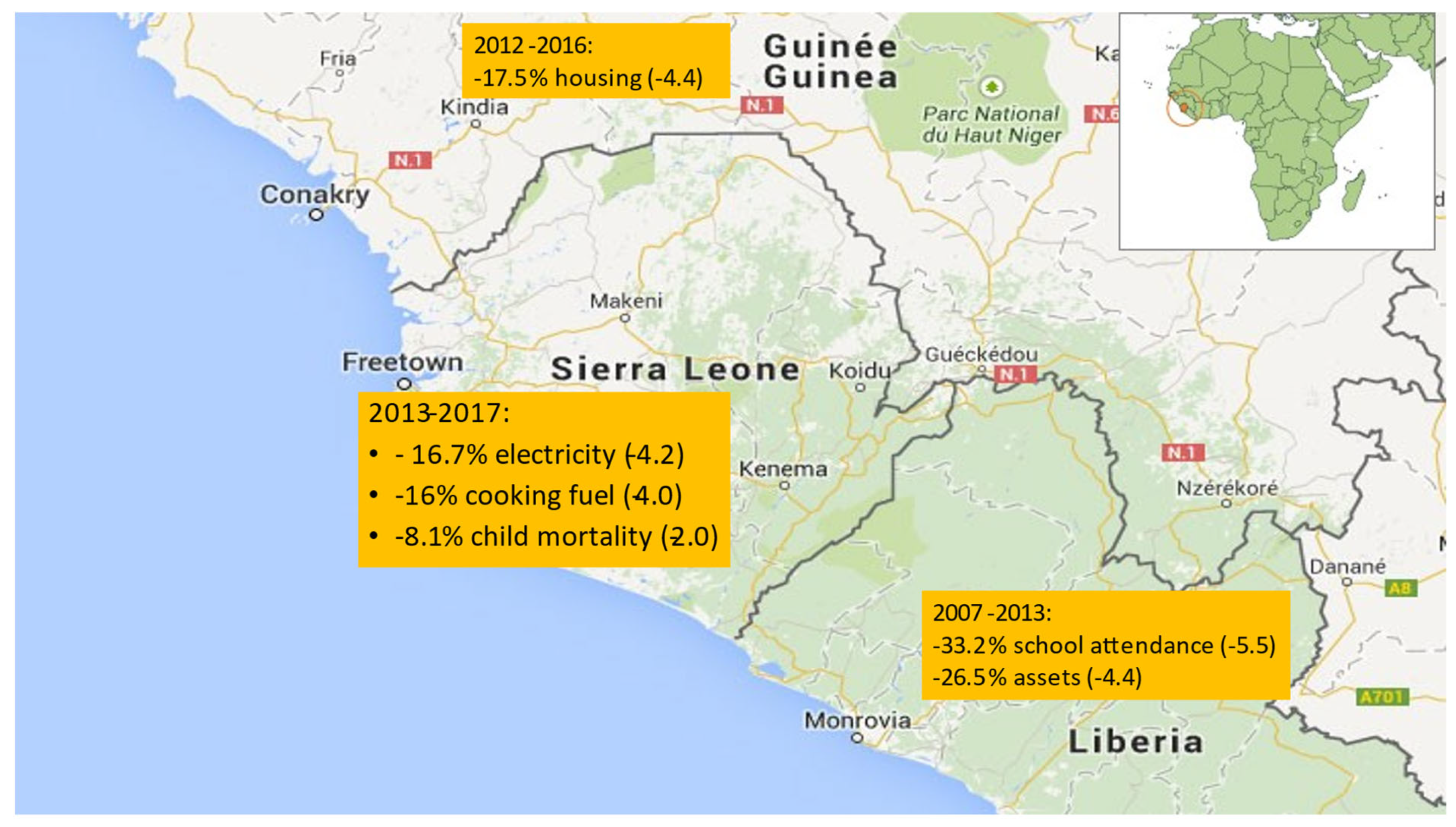
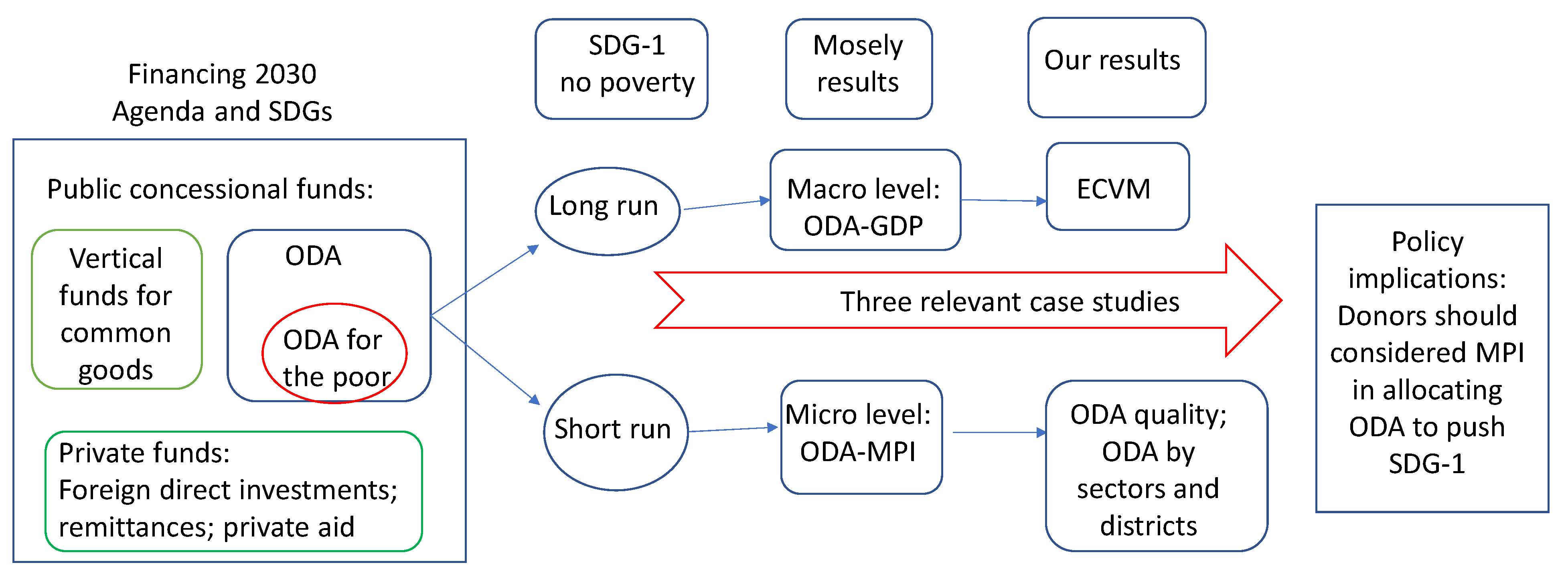
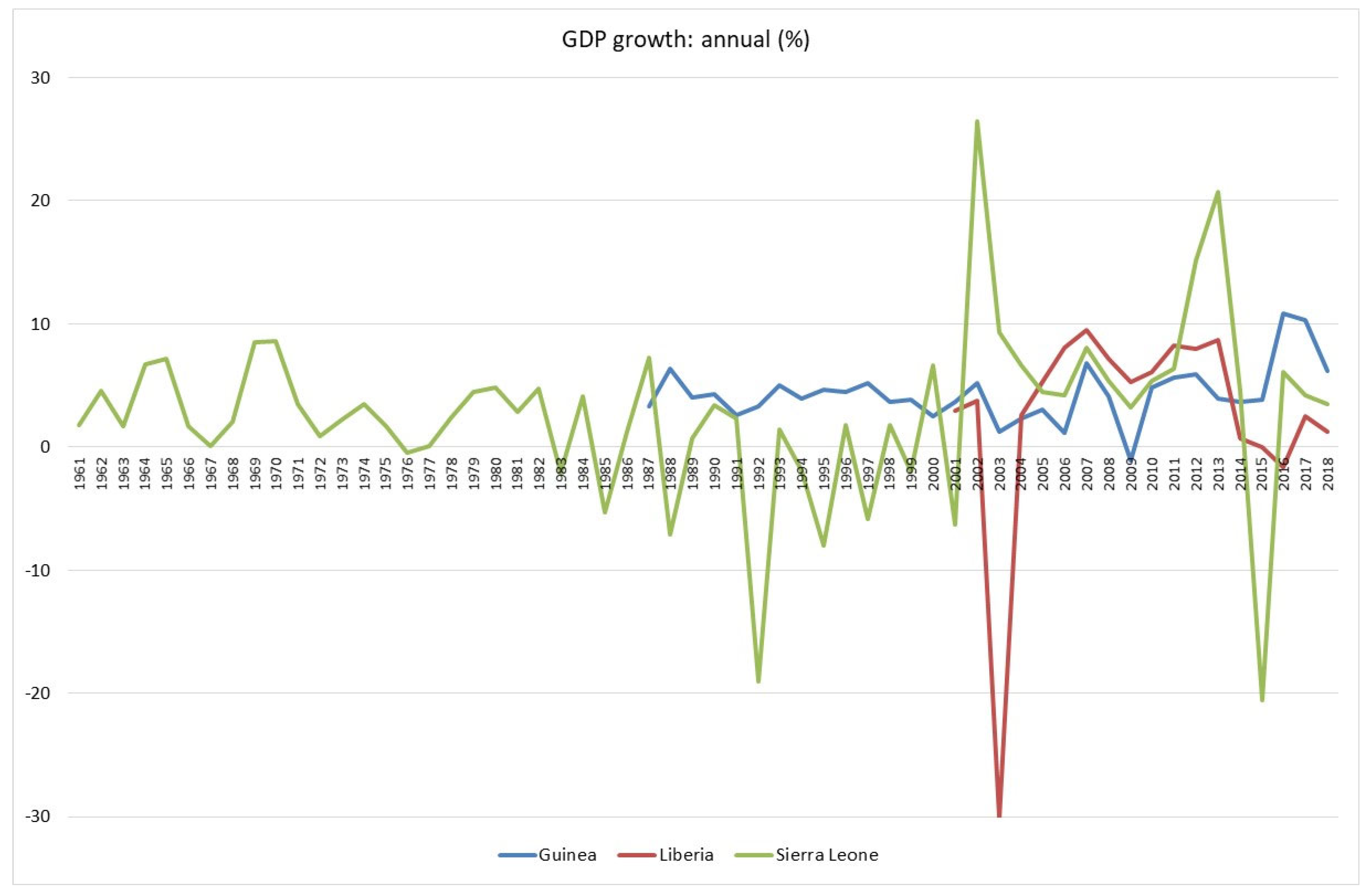

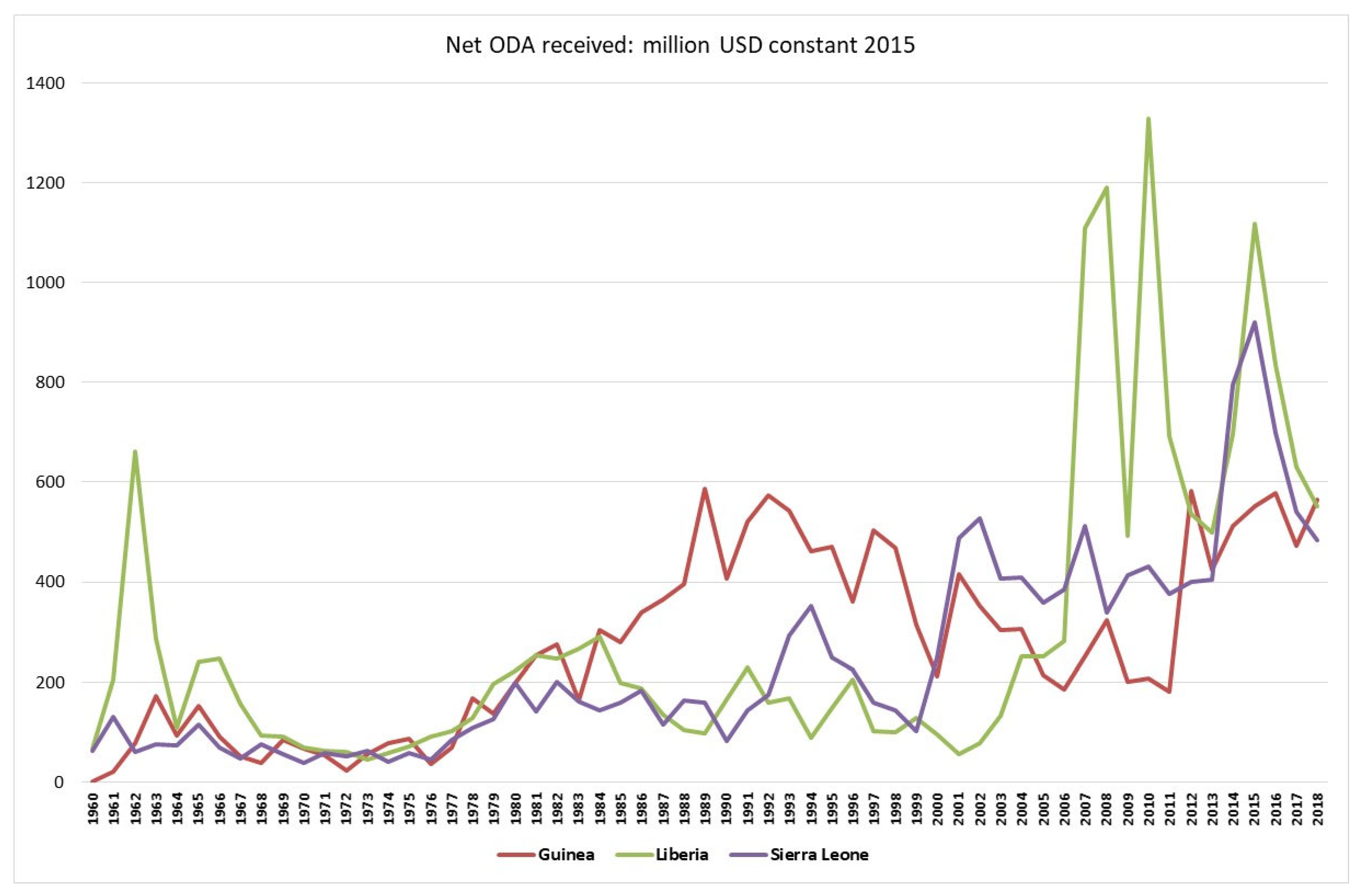
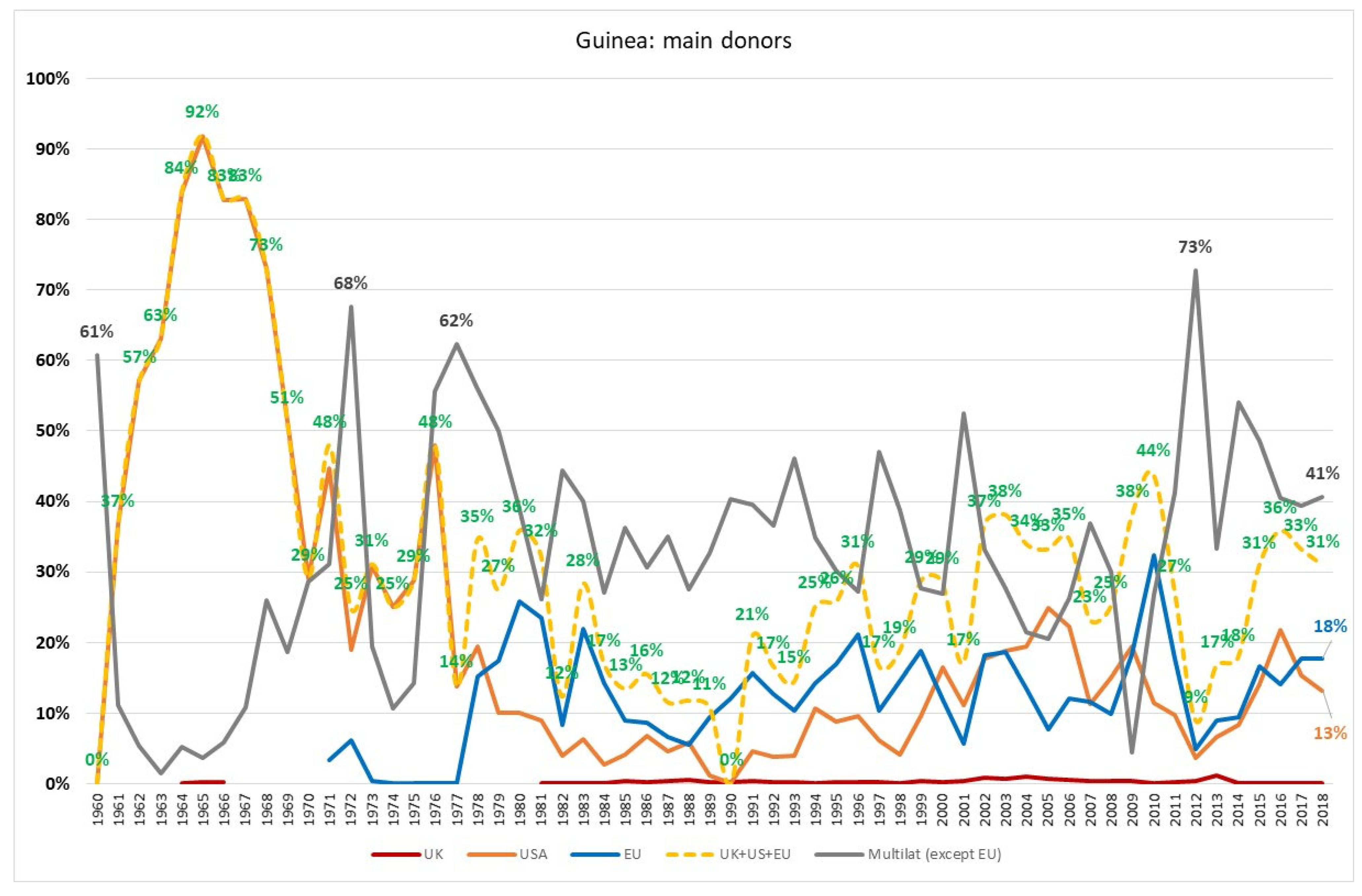


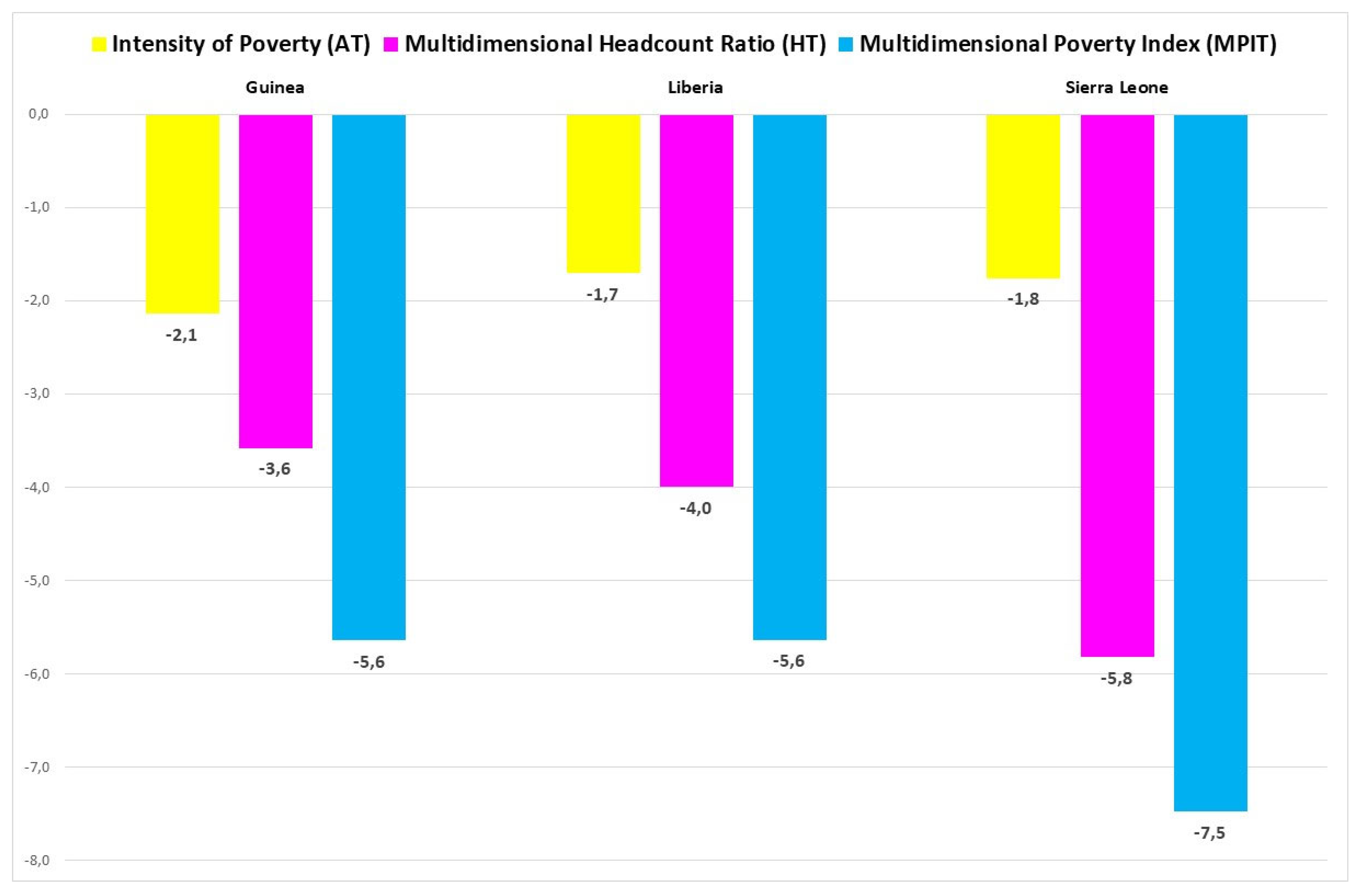
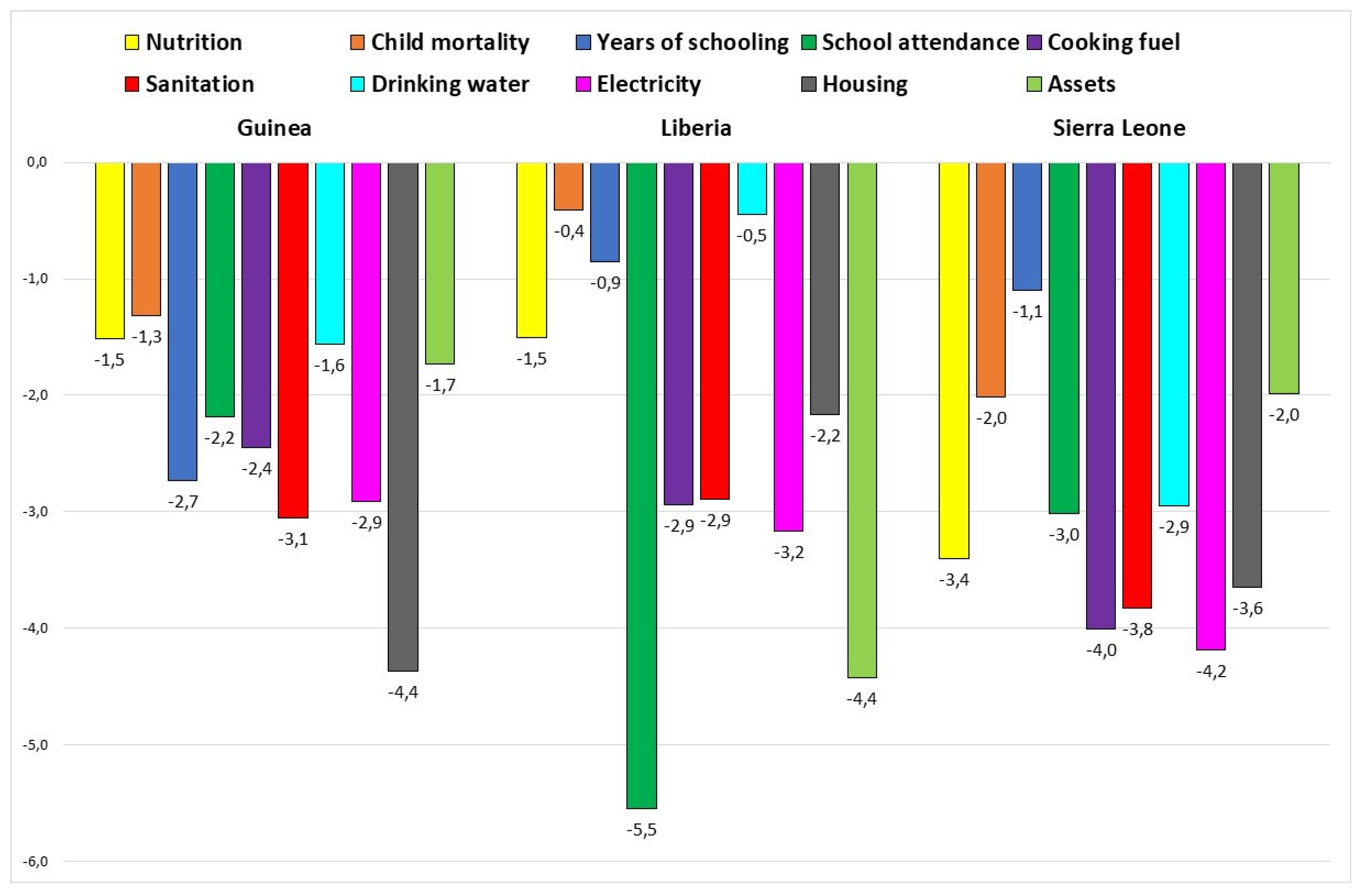
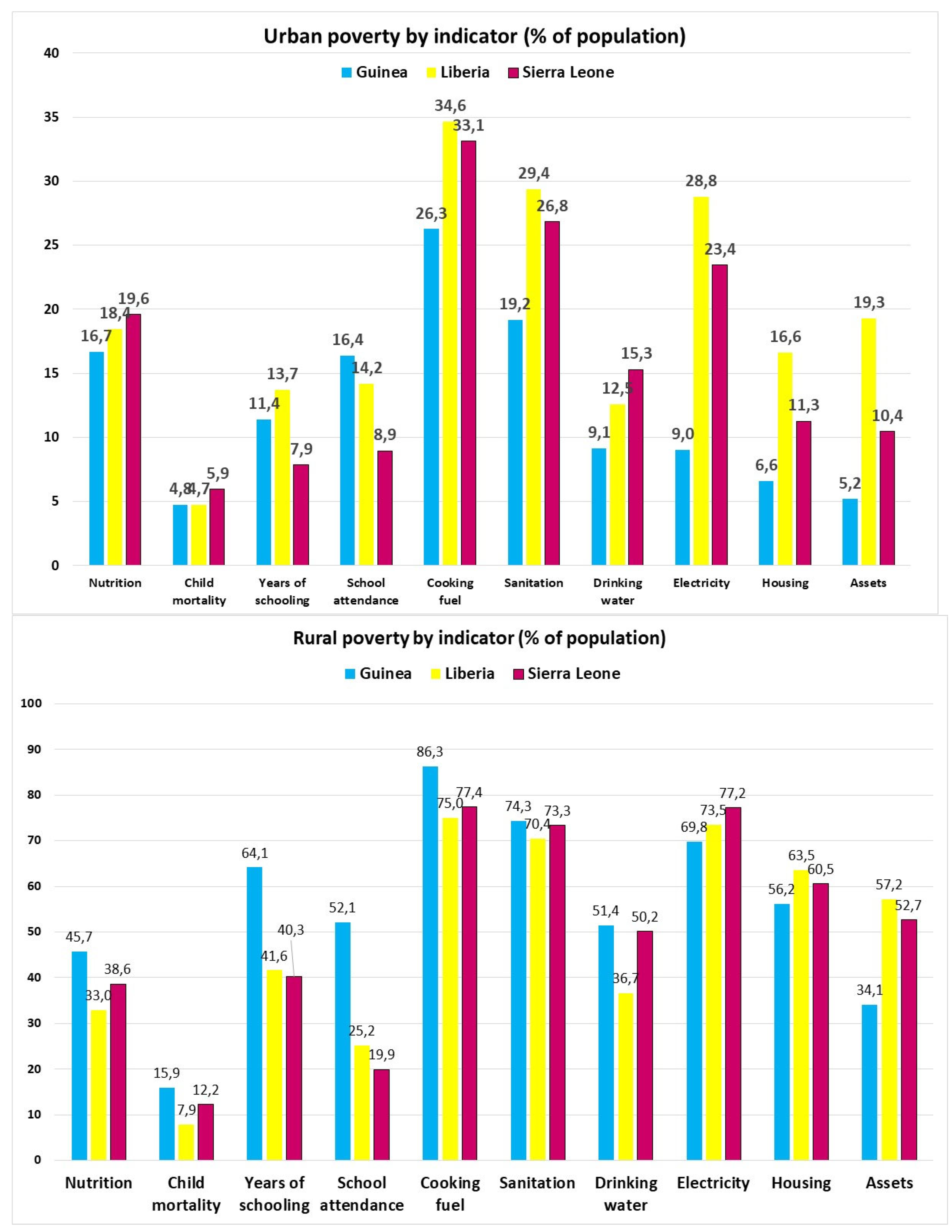
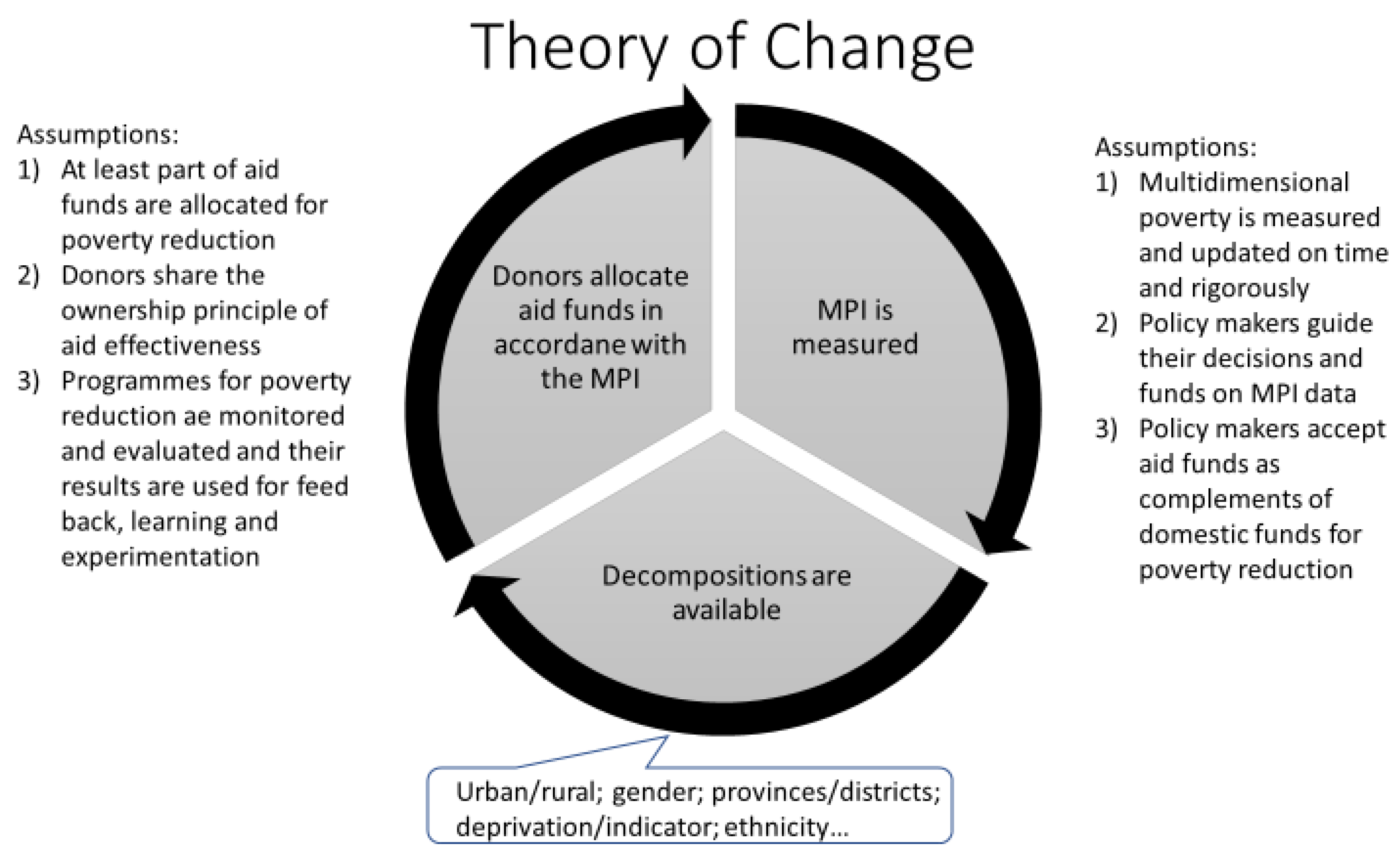
| Country | Exports | Imports | Agriculture | Industry | Services |
|---|---|---|---|---|---|
| Guinea | 21.9 (40% gold; 36% aluminum ores) | −36.9 (14% petroleum oils; 11% rice) | 19.8 | 32.1 | 48.1 |
| Liberia | 17.5 | −89.2 | 34 | 13.8 | 52.2 |
| Sierra Leone | 26.8 (17% motor vehicles; 14% cocoa beans) | −55.3 (rice 19%; 6.5% motor cars) | 60.7 | 6.5 | 32.9 |
| Guinea | Liberia | Sierra Leona | ||||
|---|---|---|---|---|---|---|
| Variable | p-Value | Decision | p-Value | Decision | p-Value | Decision |
| Net ODA | 0.0571 | Non-Stationary | 0.613 | Non-Stationary | 0.9586 | Non-Stationary |
| GDP | 0.8974 | Non-Stationary | 0.9841 | Non-Stationary | 0.9743 | Non-Stationary |
| Gross Capital Form. | 0.6418 | Non-Stationary | 0.0594 | Non-Stationary | 0.7923 | Non-Stationary |
| Exports | 0.9082 | Non-Stationary | 0.0 | Stationary | 0.8895 | Non-Stationary |
| Imports | 0.9306 | Non-Stationary | 0.0039 | Stationary | 0.9711 | Non-Stationary |
| Consumption | 0.9162 | Non-Stationary | 0.8734 | Non-Stationary | 0.9951 | Non-Stationary |
| Guinea | Liberia | Sierra Leona | ||||
|---|---|---|---|---|---|---|
| Variable (1st diff) | p-Value | Decision | p-Value | Decision | p-Value | Decision |
| Net ODA | 0.6781 | Non-Stationary | 0.6578 | Non-Stationary | 0.0001 | Stationary |
| GDP | 0.0004 | Stationary | 0.2638 | Non-Stationary | 0.0 | Stationary |
| Gross Capital Form. | 0.0001 | Stationary | 0.0 | Stationary | 0.0 | Stationary |
| Exports | 0.0 | Stationary | - | - | 0.0 | Stationary |
| Imports | 0.0044 | Stationary | - | - | 0.0 | Stationary |
| Consumption | 0.0003 | Stationary | 0.0001 | Stationary | 0.0064 | Stationary |
| Guinea | Liberia | Sierra Leone | |
|---|---|---|---|
| Lag order | 2 | 0 | 2 |
| Cointegration rank | 4 | 0 | 1 |
| Year | 2008 | 2011 | 2016 | 2018 | ||||||||||||
|---|---|---|---|---|---|---|---|---|---|---|---|---|---|---|---|---|
| Indicator/Country | Guinea | Liberia | Sierra Leone | Africa | Guinea | Liberia | Sierra Leone | Africa | Guinea | Liberia | Sierra Leone | Africa | Guinea | Liberia | Sierra Leone | Africa |
| % of use of country-owned results frameworks by providers of development co-operation (SDG 17.15.1) | 72.1% | 44.4% | 49.4% | 66.0% | ||||||||||||
| % of new development interventions that draw objectives from country-led results frameworks | 100% | 100% | 90.0% | 84.8% | 69.2% | 100% | 88.9% | 79.7% | ||||||||
| % of results indicators drawn from country-led results frameworks | 51.9% | 51.8% | 62.8% | 60.5% | 82.5% | 33.3% | 30.0% | 62.8% | ||||||||
| % of results indicators monitored using the partner country's own sources | 48.1% | 53.5% | 40.6% | 51.3% | 64.7% | 0.0% | 29.2% | 53.7% | ||||||||
| % of new interventions that plan a final evaluation with partner country involvement | 66.7% | 11.8% | 70.4% | 51.2% | 25.0% | 0.0% | 35.7% | 54.7% | ||||||||
| Indicator 1b: Overall strength of national results framework (%) | 0.0% | 70.9% | 70.5% | 67.8% | ||||||||||||
| Indicator 5a: Annual predictability of development co-operation | 99.3% | 79.5% | 79.3% | N.A. | 33.3% | 88.1% | 79.5% | 96.8% | 75.1% | 94.1% | 72.4% | 97.0% | 98.1% | 100% | 86.0% | |
| Indicator 5b: Medium-term predictability of development co-operation | 100% | 100% | 53.3% | 61.2% | N.A. | 53.3% | N.A. | 59.9% | ||||||||
| Indicator 6: Development co-operation is on budgets which are subject to parliamentary scrutiny | N.A. | 38.8% | 54.0% | N.A. | 100% | 29.2% | 21.3% | 41.4% | 100% | 9.3% | 45.0% | N.A. | 100% | N.A. | 50.2% | |
| Indicator 9b: Use of partner countries public financial management and procurement systems to deliver development co-operation | 24.0% | 24.6% | 31.8% | N.A. | 39.6% | 32.9% | 34.8% | 12.8% | 81.1% | 46.9% | 36.8% | 16.5% | 8.8% | 0.2% | 28.1% | |
| Indicator 10: Aid is untied | 66.2% | 38.3% | 65.6% | 87.6% | 88.4% | 91.3% | 80.6% | 91.9% | 84.4% | 95.8% | 82.4% | N.A. | 71.6% | 94.2% | 82.7% | |
| Guinea 2012-16 | Liberia 2007-13 | Sierra Leone 2013-17 | Guinea | Liberia | Sierra Leone | ||||
|---|---|---|---|---|---|---|---|---|---|
| Year | TOTAL | % | TOTAL | % | TOTAL | % | |||
| Sector | |||||||||
| 1000: Total All Sectors | 3229.21 | 7122.85 | 3.783.63 | ||||||
| 450: Total Sector Allocable | 1657.40 | 51.3% | 3270.15 | 45.9% | 2004.48 | 53.0% | Years schooling | ||
| 100: I. Social Infrastructure & Services, Total | 1203.38 | 37.3% | 2276.06 | 32.0% | 1479.48 | 39.1% | −2.7 | −0.9 | −1.1 |
| 110: I.1. Education, Total | 195.52 | 6.1% | 200.13 | 2.8% | 132.69 | 3.5% | School attendance | ||
| 112: I.1.b. Basic Education, Total | 46.81 | 1.4% | 108.58 | 1.5% | 62.26 | 1.6% | −2.2 | −5.5 | −3.0 |
| 120: I.2. Health, Total | 468.70 | 14.5% | 381.38 | 5.4% | 542.08 | 14.3% | |||
| 122: I.2.b. Basic Health, Total | 394.46 | 12.2% | 311.88 | 4.4% | 433.52 | 11.5% | |||
| 130: I.3. Population Policies/Programmes & Reproductive Health, Total | 153.14 | 4.7% | 182.07 | 2.6% | 259.62 | 6.9% | |||
| 140: I.4. Water Supply & Sanitation, Total | 41.57 | 1.3% | 54.84 | 0.8% | 180.38 | 4.8% | |||
| 14030: Basic drinking water supply and basic sanitation | 13.47 | 0.4% | 21.09 | 0.3% | 4.80 | 0.1% | drinking wáter | ||
| 14031: Basic drinking water supply | 6.63 | 0.2% | 0.02 | 0.0% | 1.78 | 0.0% | −1.6 | −0.5 | −2.9 |
| 14032: Basic sanitation | 5.60 | 0.2% | 0.12 | 0.0% | 3.66 | 0.1% | Sanitation | ||
| 14050: Waste management/disposal | 1.48 | 0.0% | 2.59 | 0.0% | 5.92 | 0.2% | −3.1 | −2.9 | −3.8 |
| 150: I.5. Government & Civil Society. Total | 290.15 | 9.0% | 1380.93 | 19.4% | 280.67 | 7.4% | |||
| 160: I.6. Other Social Infrastructure & Services. Total | 54.30 | 1.7% | 76.71 | 1.1% | 84.04 | 2.2% | |||
| 16030: Housing policy and administrative management | 0.40 | 0.0% | Housing | ||||||
| 16040: Low-cost housing | 0.02 | 0.0% | 0.66 | 0.0% | −4.4 | −2.2 | −3.6 | ||
| 200: II. Economic Infrastructure & Services, Total | 257.26 | 8.0% | 687.91 | 9.7% | 322.46 | 8.5% | |||
| 210: II.1. Transport & Storage, Total | 153.77 | 4.8% | 263.36 | 3.7% | 207.37 | 5.5% | |||
| 220: II.2. Communications, Total | 31.22 | 1.0% | 22.96 | 0.3% | 6.25 | 0.2% | |||
| 230: II.3. Energy, Total | 68.75 | 2.1% | 331.31 | 4.7% | 75.72 | 2.0% | Electricity | ||
| 23630: Electric power transmission and distribution (centralised grids) | 50.17 | 1.6% | 85.17 | 1.2% | 37.52 | 1.0% | −2.9 | −3.2 | −4.2 |
| 240: II.4. Banking & Financial Services, Total | 0.93 | 0.0% | 5.40 | 0.1% | 19.12 | 0.5% | |||
| 300: III. Production Sectors, Total | 99.23 | 3.1% | 144.18 | 2.0% | 144.19 | 3.8% | |||
| 400: IV. Multi-Sector/Cross-Cutting, Total | 97.52 | 3.0% | 162.00 | 2.3% | 58.36 | 1.5% | Nutrition | ||
| 500: VI. Commodity Aid/General Programme Assistance, Total | 390.01 | 12.1% | 686.56 | 9.6% | 570.45 | 15.1% | 0.0 | −1.5 | −3.4 |
| 600: VII. Action Relating to Debt, Total | 812.50 | 25.2% | 2667.56 | 37.5% | 135.34 | 3.6% | |||
| 700: VIII. Humanitarian Aid, Total | 223.50 | 6.9% | 489.09 | 6.9% | 973.03 | 25.7% | cooking-fuel | ||
| 910: Administrative Costs of Donors, Total | 8.70 | 0.3% | 4.10 | 0.1% | 13.85 | 0.4% | −2.4 | −2.9 | −4.0 |
| 930: Refugees in Donor Countries, Total | 3.58 | 0.1% | 0.53 | 0.0% | 0.58 | 0.0% | Assets | ||
| 998: IX. Unallocated/Unspecified, Total | 133.52 | 4.1% | 4.86 | 0.1% | 85.89 | 2.3% | −1.7 | −4.4 | −1.0 |
| Guinea | |||||||||
|---|---|---|---|---|---|---|---|---|---|
| Year | 2012 | 2013 | 2014 | 2015 | 2016 | Total | % | ||
| Official Donors, Total | 4.983 | 4.796 | 11.731 | 13.475 | 15.189 | 50.174 | 100.00% | ||
| France | 0.006 | .. | .. | .. | .. | 0.006 | 0.01% | ||
| EU Institutions | 0.118 | .. | .. | .. | .. | 0.118 | 0.2% | ||
| African Development Fund [AfDF] | 4.082 | 3.212 | 4.859 | 7.555 | 11.165 | 30.873 | 62% | ||
| International Development Association [IDA] | 0.776 | 1.584 | 6.872 | 5.920 | 4.024 | 19.177 | 38% | ||
| Liberia | |||||||||
| Year | 2007 | 2008 | 2009 | 2010 | 2011 | 2012 | 2013 | Total | % donor |
| Official Donors, Total | 2.154 | 9.831 | 10.126 | 16.012 | 24.004 | 21.278 | 1.766 | 85.171 | 100.0% |
| Norway | 2.130 | 6.071 | 5.358 | 10.129 | 20.580 | 19.709 | .. | 63.98 | 75.1% |
| United States | 0.024 | .. | .. | .. | .. | .. | .. | 0.024 | 0.03% |
| EU Institutions | .. | 3.760 | 4.767 | 5.883 | 3.302 | 0.076 | 0.129 | 17.917 | 21.0% |
| International Development Association [IDA] | .. | .. | .. | .. | 0.123 | 1.494 | 1.637 | 3.253 | 3.8% |
| Sierra Leone | |||||||||
| Year | 2013 | 2014 | 2015 | 2016 | 2017 | Total | % | ||
| Official Donors, Total | 0.357 | 0.247 | 12.467 | 14.039 | 10.411 | 37.521 | 100% | ||
| Japan | 0.357 | 0.247 | 9.219 | 0.201 | .. | 10.025 | 27% | ||
| United Kingdom | .. | .. | .. | 13.835 | 2.627 | 16.462 | 44% | ||
| African Development Fund [AfDF] | .. | .. | 0.071 | .. | .. | 0.071 | 0.2% | ||
| International Development Association [IDA] | .. | .. | 3.177 | 0.003 | 7.784 | 10.964 | 29% |
| Sector | Donors | Projects |
|---|---|---|
| Education | DFID (UK) | 14 |
| World Food Program | 12 | |
| Health | Irish Aid | 4 |
| Islamic Development Bank | 1 | |
| European Union | 13 | |
| Water and sanitation | DFID (UK) | 4 |
| European Union | 1 | |
| Energy | JICA (Japan) | 1 |
| Government and civil society | Irish Aid | 1 |
| DFID (UK) | 9 | |
| African Development Bank | 1 | |
| International Organization for Migrations | 2 | |
| UNDP | 1 | |
| European Union | 41 | |
| JICA (Japan) | 1 | |
| Other sectors | OPEC European Union DFID (UK) | 49 |
| Rank MPI | Rank Hc | Rank A | AidData2013–2017 by Districts | |||||
|---|---|---|---|---|---|---|---|---|
| Kenema | −0.194 | Kenema | −29.7 | Kailahun | −9.8 | Kono | 17,141,417 | 17.8% |
| Kono | −0.194 | Kono | −26.0 | Kambia | −8.3 | Tonkolili | 12,759,820 | 13.2% |
| Kambia | −0.186 | Bo | −23.6 | Tonkolili | −7.9 | Kenema | 10,610,602 | 11.0% |
| Port Loko | −0.175 | Western rural | −23.5 | Koinadugu | −7.6 | Kailahun | 7,514,619 | 7.8% |
| Kailahun | −0.172 | Port Loko | −23.2 | Moyamba | −7.5 | Bo | 5,636,842 | 5.9% |
| Bo | −0.170 | Bombali | −22.8 | Kono | −7.0 | Bombali | 5,611,655 | 5.8% |
| Moyamba | −0.161 | Kambia | −20.3 | Bo | −6.7 | Bonthe | 5,395,457 | 5.6% |
| Koinadugu | −0.140 | Western urban | −19.5 | Port Loko | −6.0 | Pujehun | 5,277,832 | 5.5% |
| Tonkolili | −0.138 | Moyamba | −17.2 | Pujehun | −5.2 | Koinadugu | 4,802,252 | 5.0% |
| Bombali | −0.136 | Kailahun | −16.8 | Kenema | −4.9 | Moyamba | 4,686,429 | 4.9% |
| Western rural | −0.118 | Tonkolili | −12.9 | Western urban | −4.4 | Port Loko | 4,547,227 | 4.7% |
| Pujehun | −0.108 | Koinadugu | −12.2 | Bombali | −2.5 | Western rural | 4,546,554 | 4.7% |
| Western urban | −0.099 | Pujehun | −11.4 | Western rural | −1.6 | Kambia | 4,177,529 | 4.3% |
| Bonthe | −0.062 | Bonthe | −10.3 | Bonthe | −0.5 | Western urban | 3,601,264 | 3.7% |
Publisher’s Note: MDPI stays neutral with regard to jurisdictional claims in published maps and institutional affiliations. |
© 2021 by the authors. Licensee MDPI, Basel, Switzerland. This article is an open access article distributed under the terms and conditions of the Creative Commons Attribution (CC BY) license (https://creativecommons.org/licenses/by/4.0/).
Share and Cite
Larrú, J.M.; González, C.Q. Aid, Multidimensional Poverty and Growth: Reversing the Micro-Macro Paradox in Guinea, Liberia and Sierra Leone. Land 2022, 11, 10. https://doi.org/10.3390/land11010010
Larrú JM, González CQ. Aid, Multidimensional Poverty and Growth: Reversing the Micro-Macro Paradox in Guinea, Liberia and Sierra Leone. Land. 2022; 11(1):10. https://doi.org/10.3390/land11010010
Chicago/Turabian StyleLarrú, José María, and Carlos Quesada González. 2022. "Aid, Multidimensional Poverty and Growth: Reversing the Micro-Macro Paradox in Guinea, Liberia and Sierra Leone" Land 11, no. 1: 10. https://doi.org/10.3390/land11010010
APA StyleLarrú, J. M., & González, C. Q. (2022). Aid, Multidimensional Poverty and Growth: Reversing the Micro-Macro Paradox in Guinea, Liberia and Sierra Leone. Land, 11(1), 10. https://doi.org/10.3390/land11010010






